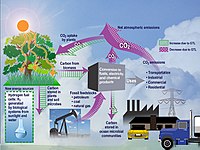
Photo from wikipedia
This article describes the design, construction, and field‐testing of a standalone networked animal‐borne monitoring system conceived to study community ecology remotely. The system consists of an assemblage of identical battery‐powered… Click to show full abstract
This article describes the design, construction, and field‐testing of a standalone networked animal‐borne monitoring system conceived to study community ecology remotely. The system consists of an assemblage of identical battery‐powered sensing devices with wireless communication capabilities that are each collar‐mounted on a study animal and together form a mobile ad hoc network. The sensing modalities of each device include high‐definition video, inertial accelerometry, and location resolved via a global positioning system module. Our system is conceived to use information exchange across the network to enable the devices to jointly decide without supervision when and how to use each sensing modality. The ultimate goal is to extend battery life while making sure that important events are appropriately documented. This requires judicious use of highly informative but power‐hungry sensing modalities, such as video, because battery capacity is constrained by stringent weight and dimension restrictions. We have proposed algorithms to regulate sensing rates, data transmission among devices, and triggering for video recording based on location and animal group movements and configuration. We have also developed the hardware and firmware of our devices to reliably execute these algorithms in the exacting conditions of real‐life deployments. We describe validation of the performance and reliability of our system using deployment results for a mission in Gorongosa National Park (Mozambique) to monitor two species in their natural habitat: the waterbuck and the African buffalo. We present movement data and snapshots of animal point‐of‐view videos collected by 14 fully operational devices collared on 10 waterbucks and 4 buffaloes.
Journal Title: Journal of Field Robotics
Year Published: 2019
Link to full text (if available)
Share on Social Media: Sign Up to like & get
recommendations!